The Disdyakis Dodecahedron
The disdyakis dodecahedron is a 3D Catalan solid bounded by 48 scalene triangles, 72 edges (24 short, 24 medium, 24 long), and 26 vertices. It is the dual of the great rhombicuboctahedron.
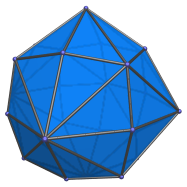
The triangular faces are transitive but irregular. The ratio of edge lengths is √(22−12√2) : 3 : 2√(9−4√2), or approximately 0.745 : 1 : 1.219. Each face represents a fundamental domain of octahedral symmetry, the symmetry shared by all the polyhedra of the cube family.
The 26 vertices are of three kinds: 6 apical vertices corresponding to an inscribed octahedron, 8 vertices corresponding to an inscribed cube, and 12 vertices corresponding to an inscribed cuboctahedron.
The name disdyakis dodecahedron refers to its topological construction from the rhombic dodecahedron by raising pyramids on the latter's rhombic faces. This construction is only topological, though, because the vertices of a rhombic dodecahedron do not quite coincide with the apical and cubical vertices of the disdyakis dodecahedron, and a slight deformation would be needed after erecting the pyramids in order to obtain a true disdyakis dodecahedron.
Projections
The following are images of the disdyakis dodecahedron from various viewpoints:
| Projection | Description |
|---|---|
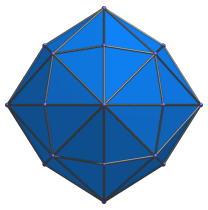 |
Front view, centered on an axial vertex. |
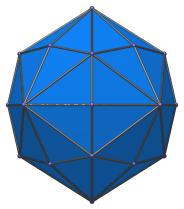 |
Side view, centered on a cuboctahedron vertex. |
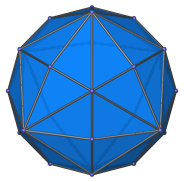 |
Octant view, centered on a cube vertex. |
Animation
Here's an animation of a disdyakis dodecahedron rotating around the vertical axis:
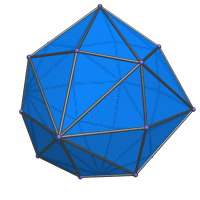
Coordinates
The Cartesian coordinates for the disdyakis dodecahedron, obtained by inverting a great rhombicuboctahedron centered on the origin with edge length 2, are all permutations of coordinate and changes of sign of:
- (0, 0, 9+3√2)
- (0, 6+3/√2, 6+3/√2)
- (7, 7, 7)
These coordinates are obtained by inverting a dual great rhombicuboctahedron of edge length (2√2−2)/21.




